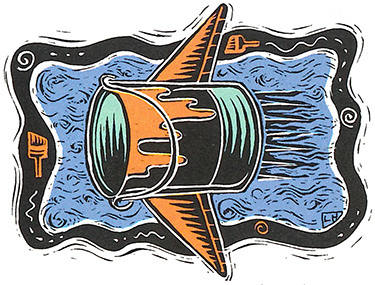Paint that ‘feels’ makes aircraft test like a breeze
 A paint that gets brighter as air pressure drops promises to make aircraft tests more efficient and cheaper. Traditional wind-tunnel tests sometimes look like a pasta factory in overdrive. Up to a thousand sensors are attached to a wing, with a thousand tubes running between the sensors and the pressure meters. “It looks like spaghetti,” notes UW Researcher Martin Gouterman.
A paint that gets brighter as air pressure drops promises to make aircraft tests more efficient and cheaper. Traditional wind-tunnel tests sometimes look like a pasta factory in overdrive. Up to a thousand sensors are attached to a wing, with a thousand tubes running between the sensors and the pressure meters. “It looks like spaghetti,” notes UW Researcher Martin Gouterman.
Not only does it look messy, but the tests are costly, cumbersome and incomplete. Because of the thinness of the wing tips, sensors cannot be placed in some areas.
Gouterman has invented a new paint that promises better pressure readings at a lower cost. The pressure-sensitive paint absorbs ultraviolet light and re-emits visible red light. The lower the air pressure, the brighter the light.
Spread thinner than a thousandth of a inch across a model’s wing surface, the paint can reveal the low-pressure areas when wind whooshes past. This is crucial because low pressure on a wing’s top and the relative high pressure underneath account for the lift force that keeps a plane aloft.
Gouterman’s work has already changed the way aeronautics engineers think about the lift force. Areas of the airfoil where sensors couldn’t be placed are “creating more lift than anyone had imagined,” he reports. The UW has applied for a patent for the new paint and has licensed it to Boeing, which plans to use it in tests for its next generation of aircraft.